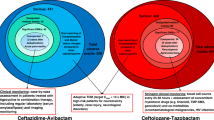Abstract
Because penicillin agents are implicated in granulopoiesis inhibition, healthcare professionals frequently consider discontinuation of such therapy in patients with decreasing white blood cell counts. No systematic review to date has described piperacillin and the patient population at risk for this adverse drug reaction (ADR).
This review sought to assess the occurrence of piperacillin-induced neutropenia, describe characteristics of affected patients and assess the reporting modalities that most accurately classify this ADR. Case reports, cohort studies and clinical trials identified by comprehensive searches of PubMed and the US FDA Adverse Event Reporting System (AERS) database were reviewed for patient demographics, duration and dose of piperacillin or piperacillin-tazobactam treatment and the occurrence of neutropenia. Causality assessments were performed.
Six published case reports, three cohort studies, 178 clinical trials and two compilations of phase I–III trials were reviewed. Review of case reports was notable in that the duration of β-lactam therapy prior to the noting of leukopenia always exceeded 15 days. No deaths were recorded in this group. Among 13 816 patients enrolled in non-neutropenic fever studies, the occurrence of piperacillin-induced neutropenia was rare: five patients (0.04%) developed neutropenia; none died. The demographics for this group were poorly documented. Through the AERS database, we identified 366 unique cases of piperacillin or piperacillin-tazobactam-induced haematological abnormalities, including neutropenia (n = 183, 50.0%), leukopenia, (n = 99, 27%), agranulocytosis (n = 58, 15.8%) and others. In 62 cases, patients received between 1 and 14 days of therapy (mean 7.7 + 4.1 days). Overall, there were 82 (22.4%) deaths.
Reports of haematological ADRs among patients receiving piperacillin or piperacillin-tazobactam are rare. Report of neutropenia associated with piperacillin usage prior to 15 days of therapy is a novel finding that requires further evaluation. Current reporting methods poorly characterise patient groups at risk.








Similar content being viewed by others
References
Neftel KA, Hauser SP, Muller MR. Inhibition of granulopoiesis in vivo and in vitro by beta-lactam antibiotics. J Infect Dis 1985; 152(1): 90–8
Spain D, Clark T. A case of agranulocytosis occurring during the course of penicillin therapy. Ann Intern Med 1946 (25): 732–3
Singh N, Yu VL, Mieles LA, et al. Beta-Lactam antibiotic-induced leukopenia in severe hepatic dysfunction: risk factors and implications for dosing in patients with liver disease. Am J Med 1993; 94(3): 251–6
Olaison L, Alestig K. A prospective study of neutropenia induced by high doses of beta-lactam antibiotics. J Antimicrob Chemother 1990; 25(3): 449–53
Behbahani R, Kostman JR. Hypersensitivity reaction during prolonged use of piperacillin/tazobactam in treatment of osteomyelitis. Ann Pharmacother 1995; 29(9): 936–7
Gerber L, Wing EJ. Life-threatening neutropenia secondary to piperacillin/tazobactam therapy. Clin Infect Dis 1995; 21(4): 1047–8
Kirkwood CF, Lasezkay GM. Neutropenia associated with mezlocillin and piperacillin. Drug Intell Clin Pharm 1985; 19(2): 112–4
Kumar A, Choudhuri G, Aggarwal R. Piperacillin induced bone marrow suppression: a case report. BMC Clin Pharmacol 2003; 3(1): 2
Rye PJ, Roberts G, Staugas RE, et al. Coagulopathy with piperacillin administration in cystic fibrosis: two case reports. J Paediatr Child Health 1994; 30(3): 278–9
Ruiz-Irastorza G, Barreiro G, Aguirre C. Reversible bone marrow depression by high-dose piperacillin/tazobactam. Br J Haematol 1996; 95(4): 611–2
Wilson C, Greenhood G, Remington JS, et al. Neutropenia after consecutive treatment courses with nafcillin and piperacillin. Lancet 1979; 1(8126): 1150
Peralta FG, Sanchez MB, Roiz MP, et al. Incidence of neutropenia during treatment of bone-related infections with piperacillin-tazobactam. Clin Infect Dis 2003; 37(11): 1568–72
Khan F. Severe nuetropenia secondary to piperacillin/tazobactam therapy. Indian J Pharmacol 2005; 37: 192–3
Zosyn® (Piperacillin and tazobactam) [product information]. Philadelphia (PA): Wyeth Pharmaceuticals, Oct 2005
Bennett CL, Nebeker JR, Lyons EA, et al. The Research on Adverse Drug Events and Reports (RADAR) project. JAMA 2005; 293(17): 2131–40
Kjaeldgaard P, Arffmann S, Heilesen AM. Bone marrow function after treatment with piperacillin (Ivacin) and tobramycin (Nebcina) [in Danish]. Ugeskr Laeger 1987; 149(37): 2470
Sugimoto M, Wakabayashi Y, Shiokawa Y. A case of piperacillin induced leucopenia whose CFU-C derived colony was inhibited in vitro by the coexisting addition of drug, serum, and mononuclear cells [in Japanese]. Rinsho Ketsueki 1984; 25(2): 197–202
Lang R, Lishner M, Ravid M. Adverse reactions to prolonged treatment with high doses of carbenicillin and ureidopenicillins. Rev Infect Dis 1991; 13(1): 68–72
Reichardt P, Handrick W, Linke A, et al. Leukocytopenia, thrombocytopenia and fever related to piperacillin/tazobactam treatment: a retrospective analysis in 38 children with cystic fibrosis. Infection 1999; 27(6): 355–6
Kuye O, Teal J, De Vries VG, et al. Safety profile of piperacillin/tazobactam in phase I and III clinical studies. J Antimicrob Chemother 1993; 31Suppl. A: 113–24
Wise R. The efficacy and safety of piperacillin/tazobactam in the therapy of bacteraemia. J Antimicrob Chemother 1993; 31Suppl. A: 97–104
Yow MD, Taber LH, Barrett FF, et al. A ten-year assessment of methicillin-associated side effects. Pediatrics 1976; 58(3): 329–34
Acknowledgements
This review was supported in part from a grant from the National Cancer Institute 1R01CA 102713-01 (Dr Bennett) and P 30 CA60553 (Dr McKoy). The other authors received no funding for preparation or publication of this manuscript. The authors have no conflicts of interest that are directly relevant to the content of this review.
Author information
Authors and Affiliations
Corresponding author
Rights and permissions
About this article
Cite this article
Scheetz, M.H., McKoy, J.M., Parada, J.P. et al. Systematic Review of Piperacillin-Induced Neutropenia. Drug-Safety 30, 295–306 (2007). https://doi.org/10.2165/00002018-200730040-00002
Published:
Issue Date:
DOI: https://doi.org/10.2165/00002018-200730040-00002




